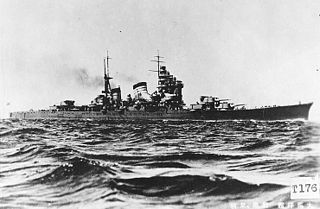At least two warships of Japan have borne the name Haguro:
- Japanese cruiser Haguro, was a Myōkō-class cruiser launched in 1928 and sunk in 1945
- JS Haguro, is a Maya-class destroyer launched in 2019
At least two warships of Japan have borne the name Haguro:

Nachi (那智) was the second vessel completed of the four-member Myōkō class of heavy cruisers of the Imperial Japanese Navy (IJN), which were active in World War II. The other ships of the class were Myōkō, Ashigara, and Haguro. She was named after a mountain in Wakayama Prefecture.

Haguro (羽黒) was a Myōkō-class heavy cruiser of the Imperial Japanese Navy, named after Mount Haguro in Yamagata Prefecture. Commissioned in 1929, Haguro saw significant service during World War II, participating in nine naval engagements. She was sunk in 1945 during a fight with Royal Navy destroyers, one of the last major Japanese warships to be sunk in open waters during World War II.
Haguro (羽黒) can refer to:

Myōkō (妙高) was the lead ship of the four-member Myōkō class of heavy cruisers of the Imperial Japanese Navy (IJN), which were active in World War II. She was named after Mount Myōkō in Niigata Prefecture. The other ships of the class were Nachi, Ashigara, and Haguro.
Several ships of the Royal Navy have been named HMS Phaeton or Phaëton after Phaëton, the son of Helios in Greek mythology:

Takao (高雄) was the lead vessel in the Takao-class heavy cruisers, active in World War II with the Imperial Japanese Navy. These were the largest cruisers in the Japanese fleet, and were intended to form the backbone of a multipurpose long-range strike force. Her sister ships were Atago, Maya and Chōkai.

The Battle of the Malacca Strait, sometimes called the Sinking of Haguro, and in Japanese sources as the Battle off Penang (ペナン沖海戦), was a naval battle that resulted from the British search-and-destroy operation in May 1945, called Operation Dukedom, that resulted in the sinking of the Japanese cruiser Haguro. Haguro had been operating as a supply ship for Japanese garrisons in the Dutch East Indies and the Bay of Bengal since 1 May 1945.
Two ships of the Imperial Japanese Navy have been named Akitsushima, the ancient name for Japan:

HMS Statesman was an S-class submarine of the Royal Navy, and part of the Third Group built of that class. She was built by Cammell Laird and launched on 14 September 1943. So far she has been the only ship of the Royal Navy to bear the name Statesman.
At least three warships of Russia have borne the name Pallada:
At least three warships of Japan have borne the name Chikuma after the Chikuma River in Nagano Prefecture:
Ibuki may refer to one of the following ships of the Imperial Japanese Navy named after Mount Ibuki:
Three warships of Japan have been named Mogami, after the Mogami River in the Tohoku region of Honshū:
At least three warships of Japan have borne the name Tone:
Two warships of the Imperial Japanese Navy were named Tatsuta:
At least five ships in the Imperial Russian, Soviet or Russian Navies have been named Varyag after the Varangian people, the Viking ancestors of the Rus.

The Maya class of guided missile destroyers in the Japan Maritime Self-Defense Force is a modified version of the Atago class, with an updated Aegis Combat System and electric propulsion system. Maya was commissioned on March 19, 2020. Haguro was commissioned on March 19, 2021.
Three ships of the Japanese Navy have been named Hashidate:
At least three warships of Japan have borne the name Maya:
Three ships of the Japanese Navy have been named Tsushima: